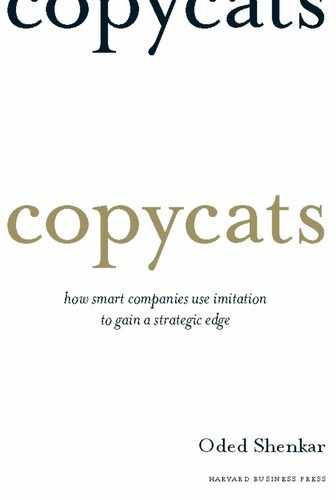Acknowledgments
The roots of this book go back a long way. Like all infants, I must have used imitation to learn how to communicate and master basic skills and, later in life, acquire social norms and mores. As an adult, I have learned the hard way that imitation is often well rewarded. Early in my scholarly career, a former classmate approached me in an academic conference to inquire about the research I was working on. Graciously, I disclosed the idea and provided a blueprint for its development and empirical investigation, including the source of data. It did not take long before I saw his copy in print, eventually forming the basis for his academic career in a center in a well-known urban university. As an older and hopefully wiser scholar, I shared an interest in innovation, imitation’s more respected sibling, which seemed to permeate virtually all significant concepts in business. It was when I combined this interest with a lifelong fascination with China, a country that was fast becoming an imitation Mecca, that I realized the importance of imitation but also its sensitivity. Indeed, I knew I was on to something when the Chinese edition of my book The Chinese Century omitted the entire chapter on intellectual property rights (IPR) infringement.
Imitation also was omnipresent in my life as a practitioner. Working with firms large and small, I have dealt with issues that, in hindsight, were all somehow connected to imitation and its supposed oxymoron, innovation, although at the time I did not connect the dots. The startups I worked with have tried to convince the venture capitalists and strategic partners I approached on their behalf that they were doing something novel, but in arguing the feasibility of the concept have often hinted that they were imitating a working model. The larger corporations I advised were keen on finding out what made their competitors tick but were loath to admit that they were imitating anyone even when it was clear that they were, or had to. “We are an innovating company,” I was constantly reminded by executives, who were expressing bewilderment and dismay at the very suggestion that they were imitating and who repeatedly questioned the premise that imitation was a reasonable, not to say a rational and profitable, course. In this book, I try to convince you otherwise.
You may be surprised to find many references to inspiration in a book about imitation, but then this is part of the message. What I would like to acknowledge here is the inspiration I received from a number of people who have made this idea come to life. They include not only the scholars from far afield, such as biology and neuroscience, and the executives who took time from their busy schedules to talk about a sensitive topic, but also several individuals who have provided vital support for my contrarian venture. Christine Poon, dean of the Fisher School at Ohio State; Steve Mangum, senior associate dean; David Greenberger, chairman of the HRM department; and members of the development office have all been highly supportive of this venture. At Harvard Business Press, Jacque Murphy has helped get the book off the ground before placing it in the very capable hands of Kathleen Carr. Kathleen was my editor and has done a superb job at that, but she fulfilled a much bigger role, that of a scholar, a colleague, and, if I may say so, a friend, deploying her intelligence, experience, and infinite patience as a still maturing product evolved.
Last but not least, thanks to my wife Miriam, who provides inspiration and support for everything I do.
